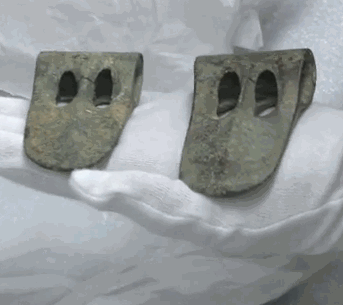University of Southern California (USC) researchers traveling to the U.S. Department of Energy’s Advanced Photon Source (APS) at Argonne will be seeking answers to worldly questions about ancient commerce.
Archaeologist Lynn Swartz Dodd of USC College and her students are taking trade artifacts from Egypt to the APS, home of the most powerful x-rays in the Western Hemisphere.The researchers will spend a week in July at the sprawling complex near Chicago.
By peering past the corroded metal on the artifacts’ surfaces and deep into their cores, Dodd and her team hope to discover the makeup and structure of the finds, which range from a series of bronze axes and swords to exquisitely forged miniature bronze-gold figurines of unknown age.
The answers may help tell the story of ancient Mediterranean trading life, which largely revolved around palatial centers.
The rulers of such palatial centers sent each other loads of gifts to “grease the wheels of trade,” Dodd said.
“(The x-ray) is a way in to understand how things operated and how trade politics, resources, moved in the ancient world. It’s a story of power and money.”
The x-ray analysis should provide clues to some basic questions. How were the figurines made? Was the technology behind the swords and axes tightly controlled or did multiple centers have access to it? If one palace owned a technology, could archaeologists try to measure its influence and wealth by searching for artifacts made the same way at other dig sites?
Unlike traditional sampling methods, x-ray analysis will not destroy or disturb the artifacts.
The group hopes to return to Argonne this fall or next spring for a second round of studies, this time to analyze Assyrian and Persian artifacts found in Israel, Turkey, Iraq and Iran, which are on loan from the Oriental Institute of Chicago.
These include what may be the earliest tin-bronze figurines, probably made by a master craftsman associated with a palace manufacturer.
“This was a cutting-edge application of metal technology in the ancient world,” Dodd said. “These figurines are the earliest tin bronzes. They’re well in advance of their time.”
The Chicago artifacts come from the royal cities of Persepolis in Iran and Khorsabad in Iraq, as well as three regional centers in the southeast corner of Turkey, just north of Syria: Tel Tayinat, an ancient capital of a small kingdom; Chatal Höyük, an ancient fabric-making center; and Tell al-Judaidah, a city that sat astride the main caravan route linking the Mediterranean to Babylon and the Silk Road.
A few smaller artifacts were excavated at Megiddo, identified in the Bible as the site of the world-ending battle of Armageddon.
The analysis will allow Dodd’s group to compare the far-flung Iron Age artifacts for clues to the politics of the time. Beginning around the 12th century B.C., palatial centers competed with imperial trade systems run by the Assyrians, Persians and Greeks.
This is not the first time that USC has brought modern technology to bear on ancient problems. Dodd’s colleague Bruce Zuckerman leads a team that has been creating digital images of the ancient writings on the Persepolis Tablets at the Oriental Institute in Chicago.
The project has two goals: to preserve at least digital access to the Iranian government-owned tablets, which may be sold off as part of a lawsuit seeking to punish Iran for its ties to the terrorist group Hamas; and to reduce physical study of the tablets by scholars.
“Looking at a text is probably the most damaging thing you can do to it,” Zuckerman said.
The original USC press release can be read here.
To view a video of Lynn Swartz Dodd discussing her upcoming work at the APS, visit https://www.youtube.com/watch?v=-Ib4GCh6mA0&feature=channel_page
For information on the digitization of the Persepolis Tablets, go to http://www.futurity.org/high-tech-cameras-digitize-ancient-tablets/
Use of the Advanced Photon Source at Argonne National Laboratory is supported by the U. S. Department of Energy, Office of Science, Office of Basic Energy Sciences, under Contract No. DE-AC02-06CH11357.
Argonne National Laboratory seeks solutions to pressing national problems in science and technology. The nation's first national laboratory, Argonne conducts leading-edge basic and applied scientific research in virtually every scientific discipline. Argonne researchers work closely with researchers from hundreds of companies, universities, and federal, state and municipal agencies to help them solve their specific problems, advance America 's scientific leadership and prepare the nation for a better future. With employees from more than 60 nations, Argonne is managed by UChicago Argonne, LLC for the U.S. Department of Energy's Office of Science.

